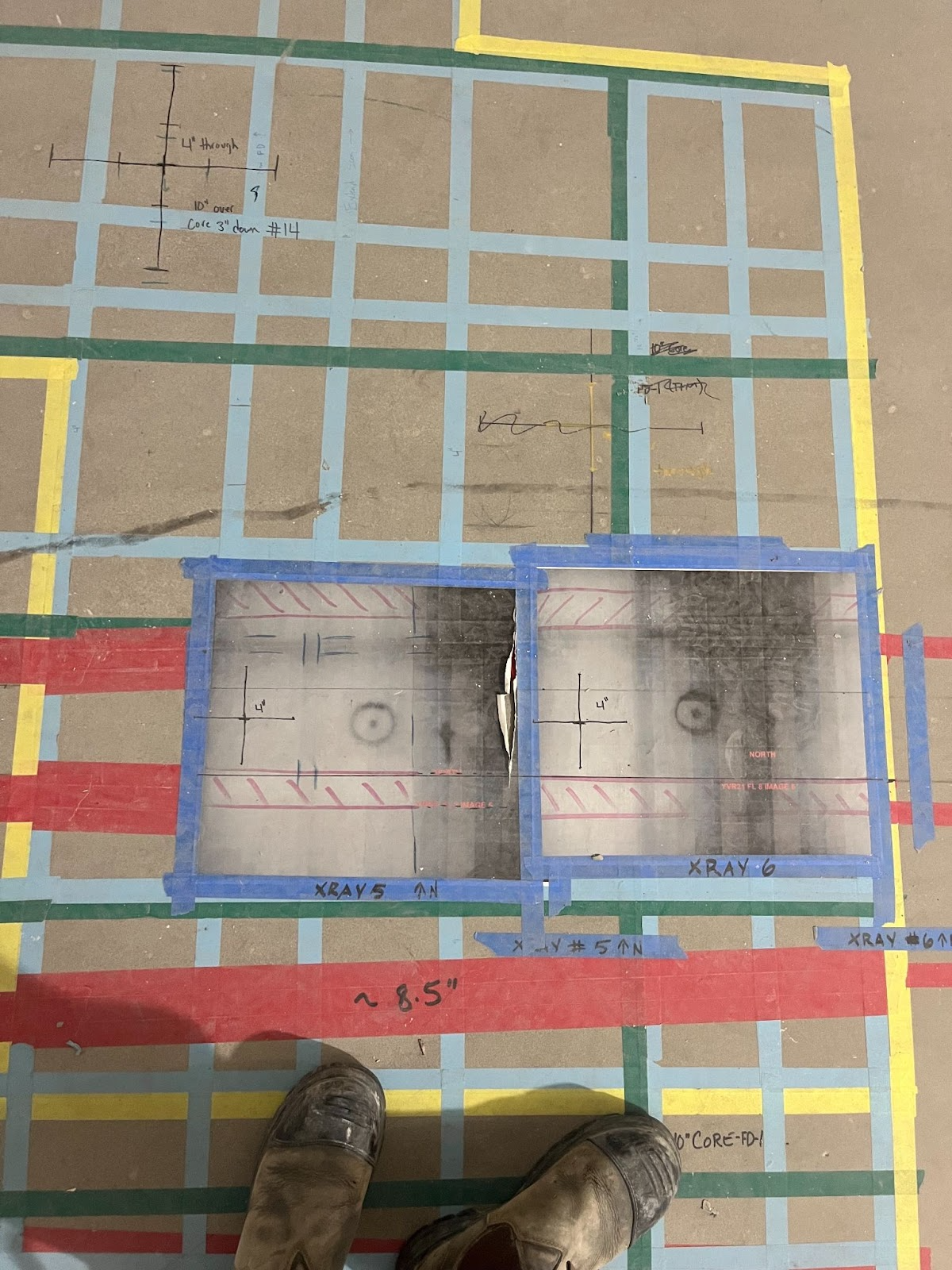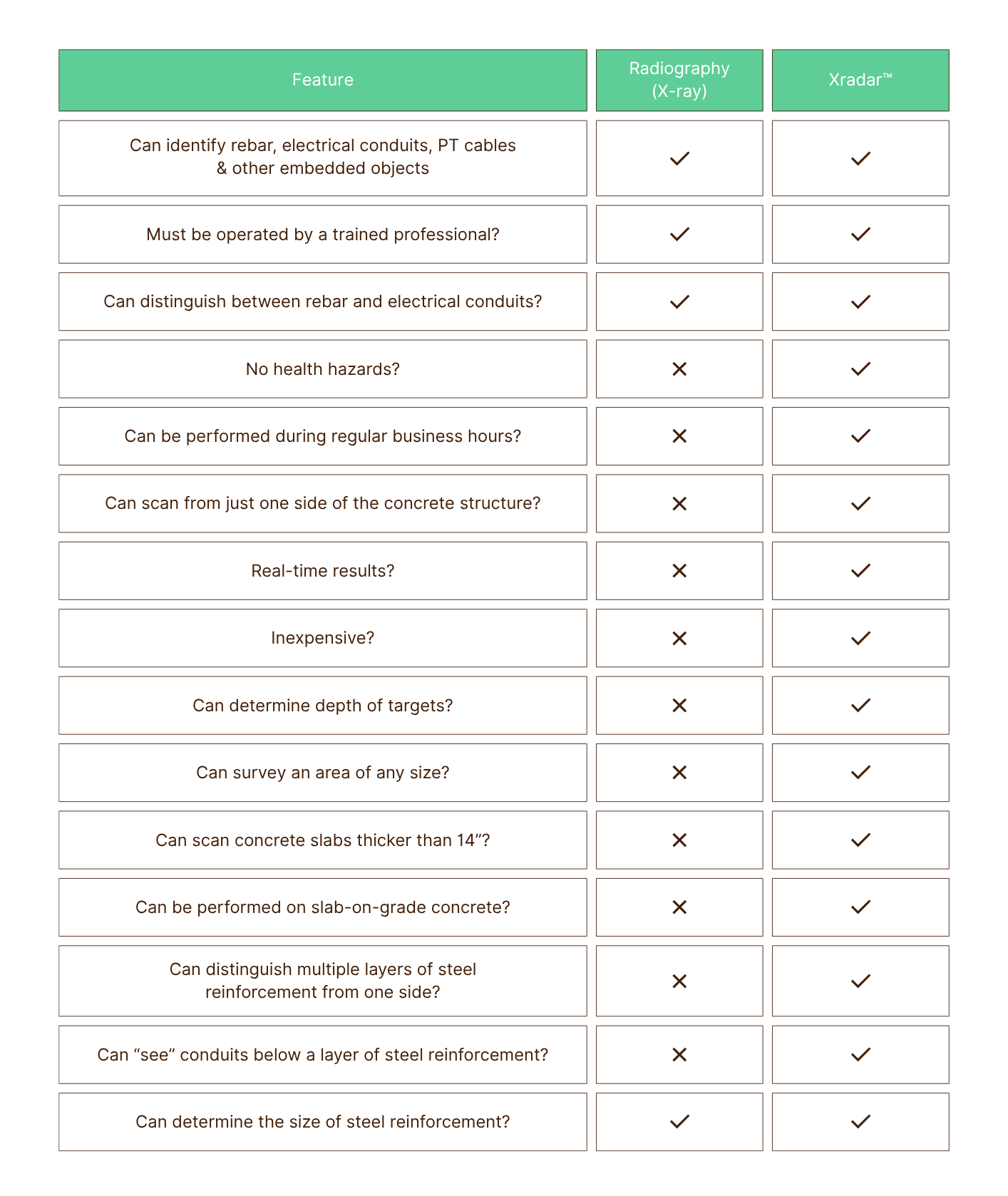This article aims to address an overlap in these technologies that use fundamentally different methods to display images of embedments within concrete. Whilst one is limited to the identification (imaging) of targets, the other benefits as the choice for core or cut positioning, as well as embedment identification.
Both methods can identify subsurface features, but GPR, and Xradar’s application of it, stand apart as the most advanced and practical use of the technology in the industry today. Knowledge refined over decades since GPRs early use within Concrete Scanning in the 1980s, Xradar delivers accurate, real-time, and safe results – without the disruption and risk associated with X-ray imaging.
While X-ray is an older method for imaging concrete structures, it has several limitations that make it less practical for today’s fast-paced, complex construction projects. Alternative methods such as Xradar are not as limiting – offering detail, speed, and flexibility without the safety concerns of radiation – Xradar can be as accurate as X-ray, with the safety and efficiency of GPR.
Let’s explore how these technologies differ, and go into detail on why Xradar is the preferred concrete scanning choice for most construction and renovation projects.
Understanding X-ray Imaging: A Traditional Approach
Concrete X-ray, also known as radiography, uses ionizing radiation to capture images of differing densities of materials inside concrete. A radiation source is placed on one side of the slab, and a detector or film is positioned on the opposite side to record the image.
While X-ray can produce detailed images of certain materials in efforts to confirm target identification, it comes with several notable limitations. It is commonly understood that X-ray should not be used for positional accuracy due to these limitations.
Limitations of Concrete X-ray imaging:
- Speed of logistics: Permits, machine warm up and setup, safety protocols, and other delays make it more expensive and slower than modern radar-based methods. It could take over an hour to get started on X-raying a square foot of concrete due to the speed of logistics, and companies may find that they have to give over 3 days notice for entering an area where exposure will happen. It is considered impractical to inspect any large area with X-ray, which is why it’s often said not to be used ‘for position’ when searching for core locations.
- Positional Accuracy: X-ray images are superimposed as a reflection, imaging specific targets in a very defined area. GPR on the other hand is used for positional accuracy in addition to identification, the initial detection, mapping embedments within a wider context of the concrete structure.
- Radiation Hazard protocols affecting schedule and cost: X-ray requires site personnel evacuations (typically over 30m radius depending on site conditions) and restricted access during scans. This often means moving projects onto night shifts, which is slow and costly. X-ray is often impossible in hospitals and other buildings that cannot be evacuated.
- Lack of depth information: X-ray images are two-dimensional, they do not reveal the depth of embedded objects, cover or slab thickness. Slab thickness is absolutely integral to coring safety.
- Depth limitations: X-ray typically cannot penetrate below a maximum slab thickness of 12-14”. You also need to know the slab thickness before commissioning X-ray, which can often cause challenges.
- Two-Sided Access: X-ray requires placement of equipment on both sides of the concrete – for this reason you cannot scan slab-on-grade, or any other concrete member/element that is inaccessible (or more inconvenient to access – such as in-use office space) from the other side.
- Limited Detection: X-ray primarily identifies dense or metallic objects. Non-metallic targets like plastic conduits or voids are commonly quite difficult without first being detected by GPR.
- Interpretation Risk: As with radar, accuracy depends heavily on the technician. X-ray also relies on subjective interpretation, and errors can happen. Identified objects can be marked incorrectly (orientation errors) due to the X-ray’s cone shaped signal (parallax effect). This can lead to misjudgments of the defect's size, shape, and precise location, potentially causing inaccurate measurements and blurring or misaligned images.

The parallax effect: Errors in X-ray setup can easily lead to misjudgments in target locations, as seen here with conduits marked up inches away from reality, almost causing a major hit.
What Is Xradar?
Xradar™ is the highest standard of GPR technology in practical application. It is a survey and analysis technique augmented with polarization and phase analysis. The extra information obtained this way eliminates major limitations of GPR and enables Xradar to see hidden objects and distinguish the size of rebar, cables and conduits. It builds upon traditional Ground Penetrating Radar but introduces advanced methodology, real-time analysis, and rigorous technician training to ensure exceptionally accurate results (below 0.03%).
The advanced capability of Xradar allows reliable detection of:
- Post-tension cables
- Top and bottom layers of rebar
- Plastic and metal conduits, including those hidden behind rebar and missed by conventional GPR
- Voids, delamination, extent of corrosion, and other subsurface defects
And because of its real-time processing and single-side access, it can be used without disrupting active job sites – a major advantage over X-ray.
Beyond GPR: Why Xradar Is Different
While GPR is widely available and the equipment easily bought off the shelf, the vast majority of people who use it do not have the proper knowledge and training to apply its practical application effectively. Poor equipment calibration, shallow interpretation skills, and limited understanding of how radar behaves in different environments (with different technology setups), lead to error rates commonly exceeding 20% – this could mean for example 1 out of 5 conduits is not detected or misidentified.
Xradar’s advanced methods, real-time analysis, and strict technician training are providing highly accurate results (<0.03% error rate).
We’ve designed our service from the ground up to eliminate variability and uncertainty, using:
- Survey and analysis methods specifically developed for concrete environments
- Highly trained, in-house technicians via the Xradar Academy
- Proven field practices and refined interpretation standards
- Complex and more expensive radar equipment. Most scanning companies use primitive GPRs like Hilti PS1000 and GSSI Mini with a limited detection capacity, just because they are cheaper and easier to use by minimally trained personnel.
It’s this combination of method, technology, and human expertise that allows Xradar to consistently deliver <0.03% error rates, even in high-risk environments.
Why Xradar Outperforms X-ray
While X-ray maintains its use in certain scenarios, Xradar offers greater flexibility, no safety concerns, and deeper material detection.
Xradar has been designed for the practical reality of the construction environment and its demands, meaning there are certain specific advantages it has over X-ray:
- Detect multiple layers of steel from one side whilst measuring depth: Xradar accurately distinguishes multiple reinforcement layers without needing access to both sides of a slab. Unlike X-ray, an Xradar scan is three-dimensional.
- Identify plastic and metal conduits below steel: We can “see” through the first reinforcement layer to locate hidden (shaded) utilities, reducing the risk of costly strikes.
- Quickly inspect large areas: Using ‘freehand’ scanning a skilled Xradar technician is able to provide fast insight on large areas of a concrete structure allowing the client to decide on locations immediately, saving time and money. Xradar is capable of a detailed scan of over 20 sq.ft of slab in an hour – a giant leap from the speed limitations seen with X-ray. With a specialized Xradar equipment setup, entire parkades or building floors can be scanned within hours.
- A skilled Xradar technician knows limitations: At most sites, Xradar technicians will find safe coring locations within 90%+ of scoped scan areas. If not, our technicians will work with you there and then to find an appropriate new location on the day. The speed gain and cost savings, compared to X-raying everything, are enormous.
The following is an extensive list of how Xradar compares to X-ray:

A Practical Application for Concrete Embedment Detection
Xradar is not just a tool – it’s a complete service built around the most effective application of GPR technology available today. Every scan uses:
- Calibrated and specialized GPR equipment
- Consistent data collection procedures trained through our own Xradar Academy
- Expert interpretation aligned to project needs
- Same day actionable reporting and easy-to-understand physical on-site markings
This leads to faster decision-making, fewer change orders, significantly reduced risk across construction timelines, with no compromise on accuracy.
X-ray scanning has its place, but Xradar is the smarter, safer, and more advanced choice for most real-world construction projects.
Book a scan with Xradar today, and experience the difference in project efficiency.
